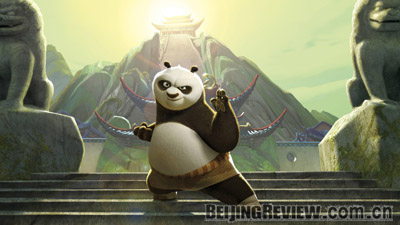|
|

|
|
PANDA POWER: The scenes and buildings in Kungfu Panda feature Chinese characteristics |
Hollywood has taken China's culture, kungfu and the iconic panda, blended them seamlessly and produced a blockbuster animated movie titled Kungfu Panda. The film's box office takings exceeded 135 million yuan ($19.8 million) in three weeks, making it the first animated movie to top the 100 million yuan ($14.7 million) mark on China's mainland.
Visually the movie hits all the right notes. Traditional Chinese architecture, soft mountain scenery, village characters, dumplings, chopsticks, noodles and the mysterious sacred home of kungfu are all presented in a very Chinese way. The characters, all animals, imitate the actions of Chinese kungfu movies to the letter, while the reluctant panda hero Paul fights like kungfu superstar Jackie Chan.
These Chinese elements aroused the interest and curiosity of Chinese audiences. But despite the huge box office haul, the movie is more of a topic in China for its controversy over exploiting national cultural heritage.
On June 16, Chinese artist Zhao Bandi, whose work mainly deals with pandas, demonstrated in front of the gate of the State Administration of Radio, Film and Television (SARFT), calling on Chinese people to boycott the movie. His reasons for protesting listed in his blog were that it was not appropriate to show the film so soon after the deadly earthquake in Sichuan Province, and that Hollywood has "stolen" Chinese cultural elements to weave an American story about success and make money in China.
The boycott gained momentum and resulted in postponement of the movie's opening in five theaters in Chengdu, capital of Sichuan.
The protest was widely reported by media in China, and sparked a debate about how Chinese should react when their culture is represented in foreign movies and then makes such an impact around the world.
Some netizens left messages saying they support Zhao and will not watch the movie. But the majority of netizens oppose Zhao's stand, saying that his boycott is just an embodiment of narrow-minded nationalism.
"It is better to learn from others than to boycott," said a blogger named Jiu Tiao Ming in his blog. "In this sense, Kungfu Panda comes at the right time."
Actually, it is not the first time that a Hollywood animated movie with Chinese cultural elements became a hit in China. Ten years ago, Mulan, an animated movie about Hua Mulan, a legendary girl in China's history who fought on the battlefield replacing her father and was held up as a female hero, rocked China's animation industry for its exploitation of Chinese cultural legacy.
But this time the impact is greater, as Chinese audiences found that kungfu Panda has gone beyond the level of Mulan in terms of using the cultural elements of another country. Unlike previous Hollywood animated movies with Chinese elements such as Mulan, which just touch the surface of Chinese culture or only use Chinese elements as symbols, the creators of Kungfu Panda have done a lot of homework and grasped the true value behind Chinese culture.
For example, one of the movie's lines, "Your mind is like this water, my friend. When it is agitated, it becomes difficult to see. But if you allow it to settle, the answer becomes clear," is actually the essence of Taoism, a traditional Chinese philosophy.
But why was such a classic animated movie not produced in China? Many Chinese artists have their own ideas.
"The only way out for Chinese animated products is to encourage original creations, which needs an entire creative phenomenon in the whole country," said Lu Shengzhang, a professor at the Animation School of the Beijing-based Communication University of China (CUC), in an interview with people.com.cn, in early July.
Besides creative ideas, Chinese artists also need financial and technological support, he said. "What is more important," he adds, "we also need the ambition, hard work and responsibility to make a quality work."
According to him, the production team behind Kungfu Panda spent five years on the movie, which cost $130 million to produce and almost $150 million to promote globally. In China, few production teams or film companies are willing to undertake such a high risk. Generally speaking, the budget for an animated movie in China is several million yuan at best and the budget for promotion is even smaller.
How to fully exploit the use of Chinese cultural elements is another problem that Chinese artists need to resolve, said Lu.
| 